The Intel Haswell-E X99 Motherboard Roundup with ASUS, GIGABYTE, ASRock and MSI
by Ian Cutress on September 25, 2014 11:30 AM ESTSystem Benchmarks
Power Consumption
Power consumption was tested on the system while in a single MSI GTX 770 Lightning GPU configuration with a wall meter connected to the OCZ 1250W power supply. This power supply is Gold rated, and as I am in the UK on a 230-240 V supply, leads to ~75% efficiency > 50W, and 90%+ efficiency at 250W, suitable for both idle and multi-GPU loading. This method of power reading allows us to compare the power management of the UEFI and the board to supply components with power under load, and includes typical PSU losses due to efficiency. These are the real world values that consumers may expect from a typical system (minus the monitor) using this motherboard.
While this method for power measurement may not be ideal, and you feel these numbers are not representative due to the high wattage power supply being used (we use the same PSU to remain consistent over a series of reviews, and the fact that some boards on our test bed get tested with three or four high powered GPUs), the important point to take away is the relationship between the numbers. These boards are all under the same conditions, and thus the differences between them should be easy to spot.


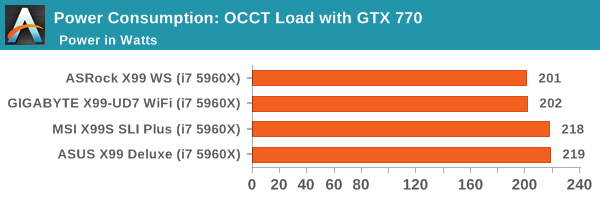
The ASRock leads the way in power consumption across the board, although the GIGABYTE has the smallest idle-to-peak delta. It will be interesting to see if this 20W window during our OCCT tests is prevalent among other X99 motherboards.
Windows 7 POST Time
Different motherboards have different POST sequences before an operating system is initialized. A lot of this is dependent on the board itself, and POST boot time is determined by the controllers on board (and the sequence of how those extras are organized). As part of our testing, we look at the POST Boot Time using a stopwatch. This is the time from pressing the ON button on the computer to when Windows 7 starts loading. (We discount Windows loading as it is highly variable given Windows specific features.)

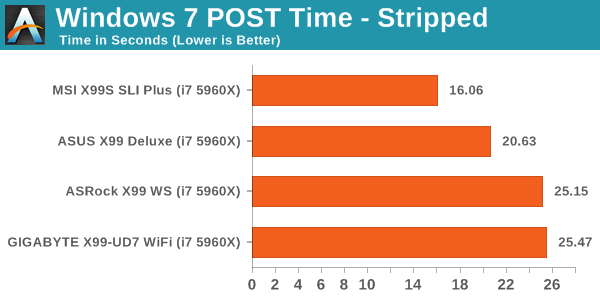
The new X99 POST sequence involves a fair amount of DRAM training (testing and verifying speeds) which adds an abnormal amount of time to the POST sequence. This is why every motherboard at default scores above 21 seconds. Not only this, but most of these BIOSes are not fully optimized in order to save time. X99 launch was rushed due to Intel, so it might be the case that we see faster times later on in the life cycle of the platform.
Rightmark Audio Analyzer 6.2.5
Rightmark:AA indicates how well the sound system is built and isolated from electrical interference (either internally or externally). For this test we connect the Line Out to the Line In using a short six inch 3.5mm to 3.5mm high-quality jack, turn the OS speaker volume to 100%, and run the Rightmark default test suite at 192 kHz, 24-bit. The OS is tuned to 192 kHz/24-bit input and output, and the Line-In volume is adjusted until we have the best RMAA value in the mini-pretest. We look specifically at the Dynamic Range of the audio codec used on board, as well as the Total Harmonic Distortion + Noise.
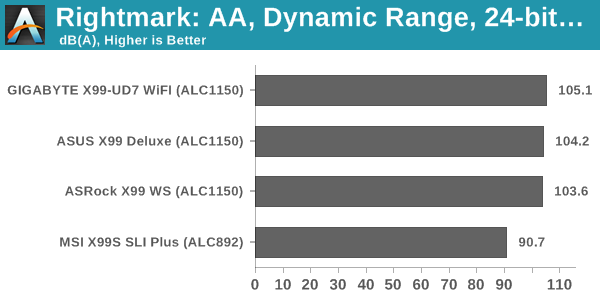
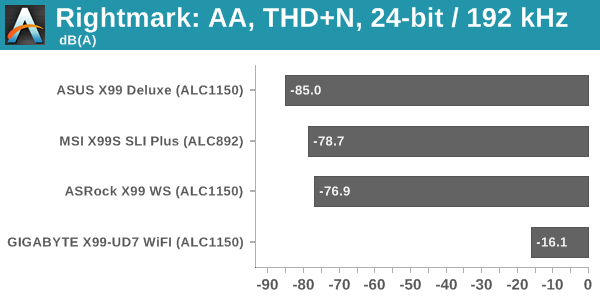
The ASUS takes the lead in THD+N by a long way, and the differences between the ALC1150s and the ALC892 in the MSI show up in the Dynamic Range tests. Unfortunately the GIGABYTE had an issue with its test, causing high levels of software-detectable distortion at high volume levels.
USB Backup
For this benchmark, we transfer a set size of files from the SSD to the USB drive using DiskBench, which monitors the time taken to transfer. The files transferred are a 1.52 GB set of 2867 files across 320 folders – 95% of these files are small typical website files, and the rest (90% of the size) are small 30 second HD videos. In an update to pre-Z87 testing, we also run MaxCPU to load up one of the threads during the test which improves general performance up to 15% by causing all the internal pathways to run at full speed.
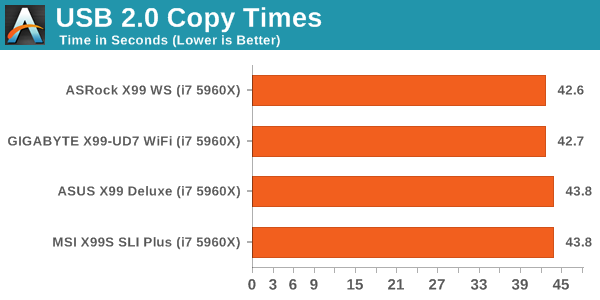

DPC Latency
Deferred Procedure Call latency is a way in which Windows handles interrupt servicing. In order to wait for a processor to acknowledge the request, the system will queue all interrupt requests by priority. Critical interrupts will be handled as soon as possible, whereas lesser priority requests such as audio will be further down the line. If the audio device requires data, it will have to wait until the request is processed before the buffer is filled.
If the device drivers of higher priority components in a system are poorly implemented, this can cause delays in request scheduling and process time. This can lead to an empty audio buffer and characteristic audible pauses, pops and clicks. The DPC latency checker measures how much time is taken processing DPCs from driver invocation. The lower the value will result in better audio transfer at smaller buffer sizes. Results are measured in microseconds.

DPC for X99 is quite impressive all around, with every motherboard scoring under 100 microseconds.










62 Comments
View All Comments
The Von Matrices - Friday, September 26, 2014 - link
Ian never said the MSI board wouldn't overclock, just that an unidentified bug causes its overclocked performance to be significantly lower than the other boards. based upon the results, putting your same CPU in the other boards would make it perform CPU 4.5% faster; alternatively, you would have to clock your CPU to 4.8GHz in the MSI board to match the 4.6GHz overclocks in the other boards.woj666 - Friday, September 26, 2014 - link
This review had the opposite result. The MSI board was able to perform even better than the others overclocked. It's disappointing but sometimes we just get bad boards.http://www.bit-tech.net/hardware/2014/09/09/x99-mo...
The Von Matrices - Saturday, September 27, 2014 - link
The bit-tech review has the CPU in the MSI board overclocked higher than the other boards, which would reasonably would make it perform better. The problem that Ian experienced is not that the board couldn't overclock the CPU; it's that at the same clock speed, the MSI board is significantly slower than its competitors, and the bit-tech results do not replicate Ian's circumstances since they have different overclocks on each CPU on each board.just4U - Thursday, September 25, 2014 - link
From the article "I have had failures in the past (Bluetooth adaptor shorting out, DRAM or PCIe slots not working, PSU going BANG… twice) "----
I was half-cut trying to install ram at 4am.. in near darkness, the combination turned into a epic fail..
owcraftsman - Thursday, September 25, 2014 - link
Very unfair to MSI to select top of the line boards for the other manufacturers and a bottom of the stack from MSI. The SLI Plus is a value edition at best so spare me an explanation.bigboxes - Friday, September 26, 2014 - link
"Due to the way the motherboard manufacturers were sampling for X99, we were unable to align several motherboards of a similar price." If you had actually read the article you may have not come across as a love struck fanboy.The_Assimilator - Friday, September 26, 2014 - link
Apparently you failed to notice (no doubt because you didn't read the article) that the MSI was gicven a "Recommended" award. Explanation: you are a tool.Laststop311 - Friday, September 26, 2014 - link
Once again Asus is on top. Their bios is the best designed with the best features. It's why my x58 board is an asus rampage formula. I'm gonna stay with x58 tho rather get a 55" LG oled TVThe Von Matrices - Saturday, September 27, 2014 - link
For the price of the ASUS board plus a 5820K CPU you could have any of the other boards plus a 5930K CPU, which would negate any performance advantage of the ASUS board. The ASUS board is only worth considering if price is no object, which from my experience seems to describe most LGA2011 buyers.Dadunn1700 - Tuesday, August 25, 2015 - link
Or u can save up for alittle while longer and get the Asus board AND the 5930k AND be faster yet again. Round and round we go. Although it's much easier to chg a CPU rather than a whole motherboard.Point is No matter what better is better....but not necessarily at the same price point. Tho I don't think $500 is a lot of money for enthusiasts to spend on PC parts. Especially essential ones. Being a flagship motherboard it's not exactly geared toward budget builders anyway....ie ppl concerned with performance per dollar. They want the best....period.
Personally I don't think $500 is a lot of money myself for a part i probably won't be replacing anytime soon.